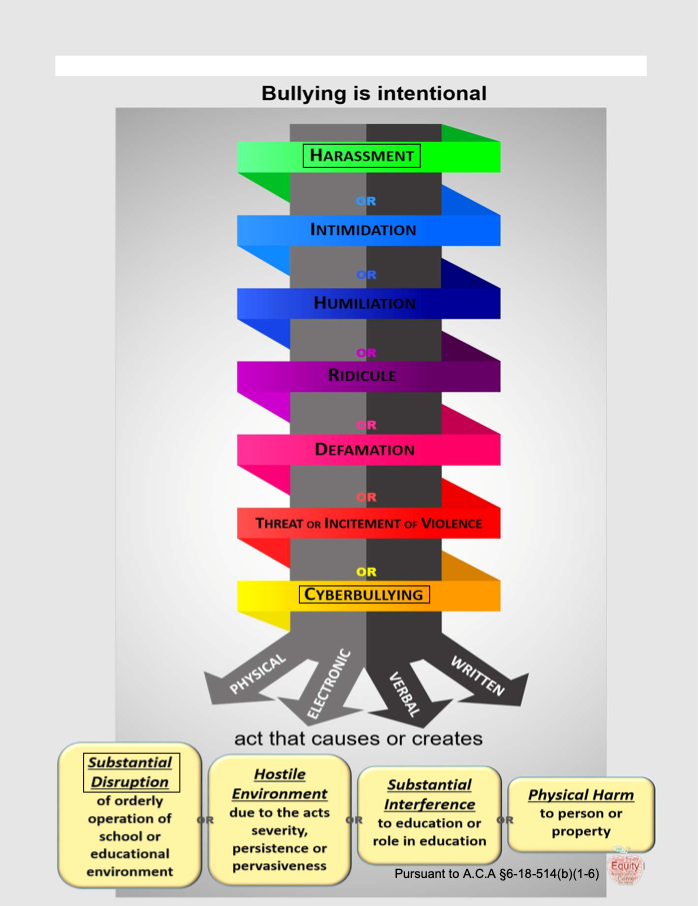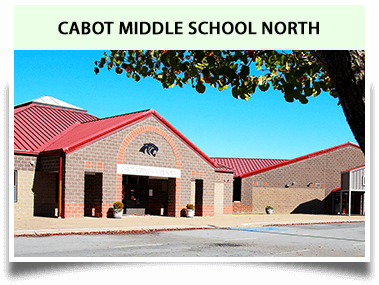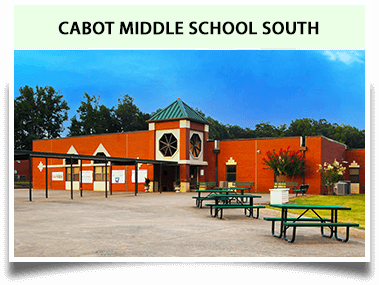Stand Up Against Bullying

WHAT IS BULLYING? BULLYING INCLUDES CYBERBULLYING BULLYING IS INTENTIONAL WHAT IF I AM BEING BULLIED? WHAT STUDENTS CAN DO IF THEY WITNESS BULLYING? DON’T BE A BULLY TIPS TO HELP IF YOU ARE BULLIED ONLINE
STAND UP AGAINST BULLYING: Be the Change
Bullying can happen in any place at any time. It can happen face to face, online or even through a cellphone.
Bullying is serious. It can threaten a student’s physical and emotional safety and negatively impact their ability to learn at school. The best way to stop bullying is to address it before it even starts.
The Cabot School District is dedicated to protecting our students. We want our kids to learn in a safe and comfortable environment. That’s why we’re encouraging everyone, students, staff, parents and community members to "Stand Up Against Bullying: Be the Change."
CSD Bullying Policy: 4.43 Panther Tip Line Bullying Report Form
WHAT IS BULLYING?
Bullying - the intentional harassment, intimidation, humiliation, ridicule, defamation, or threat or incitement of violence by a student against another student or public school employee by a written, verbal, electronic, or physical act that may address an attribute of the other student, public school employee, or person with whom the other student or public school employee is associated; involves an actual or reasonably perceived power imbalance; is repeated or has a high likelihood of repetition; and causes or creates actual or reasonably foreseeable:
Physical harm to a public school employee or student or damage to the public school employee's or student's property;
Substantial interference with a student's education or with a public school employee's role in education;
A hostile educational environment for one (1) or more students or public school employees due to the severity, persistence, or pervasiveness of the act; or
Substantial disruption of the orderly operation of the school or educational environment.
BULLYING INCLUDES CYBERBULLYING
“Cyberbullying” means any form of communication by electronic act that is sent with the purpose to:
Harass, intimidate, humiliate, ridicule, defame, or threaten a student, public school employee, or person with whom the other student or public school employee is associated; or
Incite violence against a student, public school employee, or person with whom the other student or public school employee is associated; A.C.A §6-18-514(b)(3):
BULLYING IS INTENTIONAL

The physical, social, and emotional well-being of students can be impacted by unwanted aggressive behavior or bullying.
In accordance with A.C.A. § 6-18-514, all public school students have the right to receive their education in an environment that is reasonably free from substantial intimidation, harassment, or harm or threat of harm by another student, in person or by electronic means.
For more information: https://dese.ade.arkansas.gov/Offices/District-Operations/school-safety/bullying-and-violence-prevention
WHAT IF I AM BEING BULLIED?
It is NOT okay for students to bully other students.
Report the incident as soon as possible to a trusted teacher, principal, or counselor. It is not “tattling.” Complete a Bullying Report Form or make a report using the “Panther Tip Line.”
Bullying cannot typically stop without the help of adults. If the school does not know about the bullying, it cannot address it.
When you report the bullying incident, describe exactly what happened, who was involved (first and last name), and where it occurred. Get names of children and adult witnesses.
Do not retaliate. This could result in escalation of the situation and you could be disciplined.
If the bullying continues, let an administrator know you are still having problems.
Panther Tip Line Bullying Report Form
WHAT STUDENTS CAN DO IF THEY WITNESS BULLYING?
“Bystanders” are those who witness the act of bullying at school. It is critical that these bystanders take action by getting help so the bullying will stop.
Don’t just stand there, say something. Again, complete a Complete a Bullying Report Form or make a report using the “Panther Tip Line.”
Those who bully typically think they are being cool. Students can tell a person to stop being a bully, but be careful not to use the same tactics the bully used by name calling or making fun of the bully.
Teach your child to tell an adult about bullying. It is not “tattling,” and helping a person who is being bullied is an act of courage.
Bystanders can talk to the student who is being bullied and tell him/her that it’s not his/her fault and that they need to tell an adult.
Bystanders can also talk to other bystanders and encourage them not to laugh or join in. Tell the bystanders they are part of the problem if they are not helping the person who is being bullied.
Teach your child to make friends with students who are bullied by including them in activities and conversations in the hall, in the lunchroom, and on the bus.
Panther Tip Line Bullying Report Form
DON’T BE A BULLY
The school is educating students to try to prevent bullying. You can help the school through an encouraging and safe environment at home.
Talk to your child and set the expectation that bullying is not acceptable and it must stop. Parents may have to specifically define what bullying is and what it looks and sounds like.
At home, discuss consequences for bullying.
Monitor your child’s social media, phone, and know where your child is and what they are doing. Your child may be witnessing acts of bullying and may be mimicking those acts.
Encourage your child to be active in positive groups, clubs, sports, arts, or other engaging activities that encourage accountability as a requirement for participation.
If you are worried about your child’s behavior, share it with a school counselor, teacher, or principal.
TIPS TO HELP IF YOU ARE BULLIED ONLINE
Cyberbullying involves the use of information and technology such as social media websites, e-mail, instant messaging, text messaging the publishing of false websites, and online personal polling websites that are used to support conscious, willful, deliberate, repeated, and hostile behavior by one or more people with the intent to harm others.
Protect yourself against cyberbullying.
Do not respond to rude and harassing e-mails, messages, and postings. Print a record of the evidence. Tell your parents or a trusted adult.
If you receive repeated harassing e-mails, delete the current account and open a new one.
This new e-mail address should only be provided to people you trust.
If you are receiving harassing messages through instant messaging, ask your parents to contact your service provider and learn to use the "block" feature. This will enable you to block individuals from being able to contact you through the mobile device.
If a cyberbully has created a website that is defaming or mocking you, tell your parents to contact your internet serve provider and inform law enforcement to try to get that website removed.
ADDITIONAL RESOURCES
Prevent Bullying and Cyberbullying
https://www.schoolsafety.gov/prevent/bullying-and-cyberbullying
Stop Bullying
http://www.stopbullying.gov/
SAMHSA (Substance Abuse and Mental Health Services Administration)
http://www.samhsa.gov/
SAMHSA Bullying App
https://store.samhsa.gov/product/knowbullying
National Crime Prevention Council
https://www.ncpc.org/resources/bullying/
Centers for Disease Control and Prevention - School Violence: Prevention Tools and Resources
https://www.cdc.gov/youth-violence/about/about-bullying.html
Resources for schools and districts from the federal government
Prevent Bullying and Cyberbullying
Take a look at campaigns to prevent bullying
Bullying Prevention











.png)






















